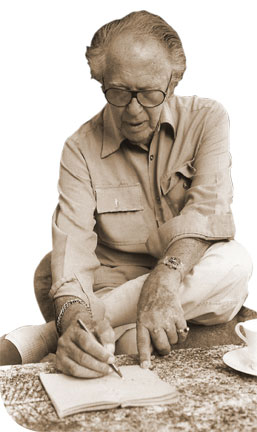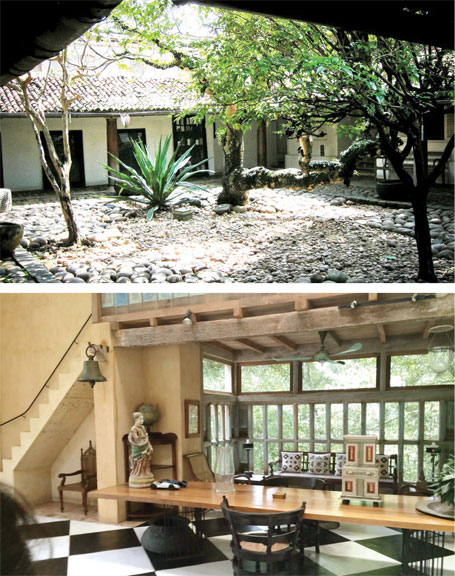|
Lunuganga and Ena de Silva House :
Geoffrey Bawa’s
Twin legacy :
By Husna Inayathullah
Lunuganga -“an extension of the surroundings – a garden within a larger
garden.”
- Bawa
 Set aside a full day or better still, two full days if you want to fully
explore Lunuganga and Bevis Bawa’s The Brief Garden. These gardens by
the brothers Geoffrey and Bevis are two very different experiences, but
the central message is the same – harmony with Nature. Not surprisingly,
all of Geoffrey’s works reflect an intense relationship with Mother
Nature and Planet Earth. Set aside a full day or better still, two full days if you want to fully
explore Lunuganga and Bevis Bawa’s The Brief Garden. These gardens by
the brothers Geoffrey and Bevis are two very different experiences, but
the central message is the same – harmony with Nature. Not surprisingly,
all of Geoffrey’s works reflect an intense relationship with Mother
Nature and Planet Earth.
Geoffrey Bawa has designed buildings all over the world, but there is one
creation that embodies his very heart and soul. It is an architectural
masterpiece and garden rolled into one. I recently had the opportunity of
visiting this famed oasis of tranquility on the Southern coast.
If fate had not intervened otherwise, I could have been admiring the view from
Lake Garda in Italy, where Geoffrey Bawa once wanted to buy a villa and create a
garden. Having decided that a career in law was not for him, he wanted to travel
around the world and see what it had in offer for him. But he could not fulfill
this dream due to various legal constraints in Italy. However, Italy’s loss was
Sri Lanka’s gain as Bawa returned to his native land and built a garden that is
second to none in the world, Italy included.
Abandoned
 Acting on the advice of his brother Bevis, he bought an abandoned rubber estate
near Bentota and set out to transform it into a tropical version of an Italian
Garden. It was this garden project that eventually awakened his interest in
architecture. Today, “Lunuganga” the Italian-inspired garden in the tropical
wilderness, is often cited as one of the greatest works of Bawa. It has a house
and garden, but you cannot separate the two. Acting on the advice of his brother Bevis, he bought an abandoned rubber estate
near Bentota and set out to transform it into a tropical version of an Italian
Garden. It was this garden project that eventually awakened his interest in
architecture. Today, “Lunuganga” the Italian-inspired garden in the tropical
wilderness, is often cited as one of the greatest works of Bawa. It has a house
and garden, but you cannot separate the two.
Bawa once said that he thought of
Lunuganga as “an extension of the surroundings – a garden within a larger
garden.” Bawa said that, for him, the most beautiful thing about Lunuganga was
“the effect of sunlight filtering through the leaves”. Geoffrey’s genius was to
create a landscape so naturalistic that it could hardly be identified as
man-made. Once a visitor to Lunuganga exclaimed, “Mr. Bawa, wouldn’t this be a
lovely place to turn into a garden?” Geoffrey said this was the best compliment
he ever received.
It lies about 60 kilometers south of Colombo and some three kilometers inland
from the coastal resort of Bentota. It is a beautiful landscape infused with the
marvellous architecture of Bawa. The garden is open to the public everyday
between 9 am to 5 pm by appointment. Lunuganga also functions as a country hotel
and maintains the special ambiance created by Geoffrey Bawa. There is only one
guest room in the main house. You can also stay in one of the five Bawa
buildings scattered through the garden. Room rates vary according to the time of
year. According to the Geoffrey Bawa Trust “As he went on to become Sri Lanka’s
and one of Asia’s most prolific and influential architects, the garden at the
Lunuganga estate remained his first muse and experimental laboratory for new
ideas. He continued to change and experiment with its spaces and structures
throughout his life until his final illness in 1998. Left to the Lunuganga Trust
on his demise in 2003, the gardens are now open to the public and the buildings
on the estate are run as a country house hotel.”
Rebuilt
If you can tear yourself away from Lunuganga, there is another place that you
must admire in Lunuganga itself. It is only now coming under the spotlight – the
renowned and rebuilt Ena de Silva House which was a Colombo landmark now rooted
in Lunuganga. It took six years for the relocation and rebuilding. Architect
Channa Daswatte, member of the Geoffrey Bawa Trust said that the Ena de Silva
house will become a guest house and people will be able to stay in the two rooms
and the studio room. “The public area will be open for the people to admire. It
will be also for the architectural students. It will be a place of education and
inspiration for the the future generation. The Geoffrey Bawa Trust has spent
approximately 30 million rupees to reconstruct the Ena de Silva house. The Trust
should continue and be able to do things like this in future,” he said.
 He further said that Ena de Silva who was originally from Matale wanted Geoffrey
to build her house in the Colombo suburb of Cinnamon Gardens in 1959. He was
introduced to her by Bevis. Bawa had just returned to Sri Lanka after his
studies at the Architectural Association in the UK. “Ena said that she wanted a
traditional house which she was used to living in coming from an old Kandyan
family. She did not wanted glass like in all modern houses but she also wanted a
touch of modern houses,” he said. He further said that Ena de Silva who was originally from Matale wanted Geoffrey
to build her house in the Colombo suburb of Cinnamon Gardens in 1959. He was
introduced to her by Bevis. Bawa had just returned to Sri Lanka after his
studies at the Architectural Association in the UK. “Ena said that she wanted a
traditional house which she was used to living in coming from an old Kandyan
family. She did not wanted glass like in all modern houses but she also wanted a
touch of modern houses,” he said.
Landscaped
The Ena de Silva house was completed in 1963. The house was constructed at No.
5, Alfred place which is right next door to what is now the Durdans Hospital. It
was built on a 30 acres landscaped garden. It was the first contemporary house
in Sri Lanka and regarded as one of the extraordinary dwellings in the country.
This remarkable building was the result of creative relationship between Ena and
Geoffrey that resulted in design of a radical house that is calmly influenced by
such diverse strains as 20th Century modernism, Sri Lankan Buddhist courtyards,
tropical regionalism and perhaps most surprisingly architecture from the Italian
Renaissance. Durdans was a small nursing home at that time in a half acre of
land. Ena lived for 15 years in that house and then she went to her hometown
after her husband’s death. The house was vacant and then she rented it - it was
her chief source of income.
It was first rented out by Bawa himself to have an office for the drawings of
the new Parliament. Most of the draftsmen lived upstairs. Afterwards it was
rented to many artists. Ena decided to sell it to her neighbouring hospital as
they needed to expand. The authorities wanted to demolish it but the Geoffrey
Bawa Trust stepped in to protest. A stay order was obtained to the effect that
the house cannot be demolished. “The trust made an appeal to the then Minister
of Culture and the Director of the Urban Development Authority to look at the
human side of it. A decision was then taken to dismantle and rebuild it. The
buyer wanted the house in two weeks and the dismantling was to be done in that
period which was a very challenging task. The house was recorded like an
architectural monument. Each section was numbered and tacked together in boxes
and was transported to Lunuganga, Bentota,” said Daswatte. This is one of the
very few such projects undertaken in the country, to demolish a building and
rebuild it somewhere else. And while in the area, do not forget to check out the
Brief Garden, a creation of Bevis Bawa. |

